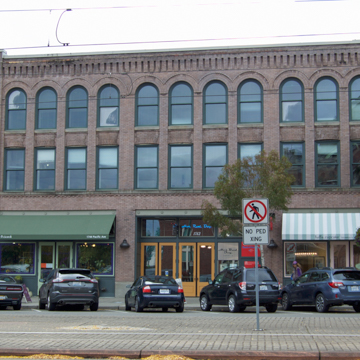You are here
Birmingham Hay and Seed Building
The Birmingham Hay and Seed Building, similar to the Birmingham Block, rises three stories along Pacific Avenue and two stories along Commerce Street. It shares common walls with the Birmingham Block and the West Coast Grocery Building, yet its brick is a lighter pink than that of its neighbors and its Romanesque Revival facade gives it distinction. In addition, a reconstructed loading dock along its south facade that serves as a covered walkway today links it with the other three buildings that make up the Academic Building at the University of Washington Tacoma.
Arched windows along the upper story and a corbeled cornice help define the building. Additional classical exterior elements include dentils running along the bottom edge of the second-story window sills. Inside, the interior has been renovated to include two lecture halls seating roughly 100 people each, along with two smaller classrooms. Space along the Pacific Avenue side outside the lecture halls has been left open to accommodate seating areas for quiet study and views of Commencement Bay and Union Depot.
Writing Credits
If SAH Archipedia has been useful to you, please consider supporting it.
SAH Archipedia tells the story of the United States through its buildings, landscapes, and cities. This freely available resource empowers the public with authoritative knowledge that deepens their understanding and appreciation of the built environment. But the Society of Architectural Historians, which created SAH Archipedia with University of Virginia Press, needs your support to maintain the high-caliber research, writing, photography, cartography, editing, design, and programming that make SAH Archipedia a trusted online resource available to all who value the history of place, heritage tourism, and learning.

